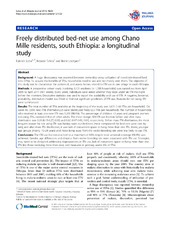| dc.description.abstract | Background: A huge discrepancy was reported between ownership versus utilization of insecticide-treated bed nets (ITNs). To acquire the benefits of ITNs, households need to use and not merely own them. The objective of this study was to characterize the pattern of, and assess factors related to ITN use in one village in south Ethiopia. Methods: A prospective cohort study involving 8,121 residents (in 1,388 households) was carried out from April 2009 to April 2011 (101 weeks). Every week, individuals were asked whether they slept under an ITN the night before the interview. Descriptive statistics was used to report the availability and use of ITN. A negative, binomial, probability, distribution model was fitted to find out significant predictors of ITN use. Reasons for not using ITN were summarized. Results: The total number of ITNs available at the beginning of the study was 1,631 (1.68 ITNs per household). On week 48, 3,099 new ITNs (PermaNet2.0) were distributed freely (2.3 ITNs per household). The number of households who received at least one new ITN was 1,309 (98.4%). The percentage of children <5 years and pregnant women not using ITNs exceeded that of other adults. The mean (range; SD) ITN use fraction before and after mass distribution was 0.20 (0.15-0.27; 0.03) and 0.62 (0.47-0.69; 0.04), respectively. Before mass ITN distribution, the most frequent reason for not using ITN was having worn out bed nets (most complained the bed nets were torn by rats); and after mass ITN distribution, it was lack of convenient space to hang more than one ITN. Males, younger age groups (mainly 15–24 years) and those living away from the vector-breeding site were less likely to use ITN. Conclusions: The ITN use fraction reached to a maximum of 69% despite near universal coverage (98.4%) was achieved. Gender, age differences and distance from vector breeding site were associated with ITN use. Strategies may need to be designed addressing disproportions in ITN use, lack of convenient space to hang more than one ITN (for those receiving more than one), and measures to prolong usable life of ITNs. | en_US |

